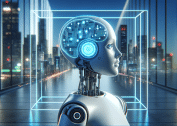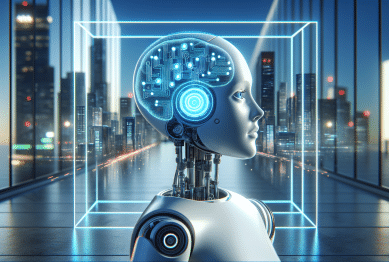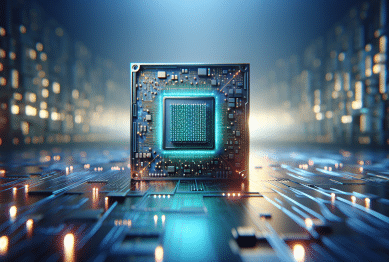Artificial intelligence shapes how individuals interact with technology daily, often without realizing it. This practical guide explores where these innovations appear, their societal impacts, and what advances in AI mean for decision-making, personal privacy, and career landscapes. Uncover the unseen ways AI transforms routines and sparks curiosity about the future.
Where Artificial Intelligence Blends Into Daily Routines
Artificial intelligence, or AI, is interwoven through many parts of the day that might seem mundane. From unlocking a smartphone using facial recognition to crafting personalized playlists on music apps, AI-powered technology is quietly transforming the user experience. Smart home devices like thermostats and speakers adapt to preferences and habits over time, providing convenience while gathering data to refine suggestions. The remarkable thing? Most of these everyday uses fly beneath the radar, operating in the background as life unfolds. Increasingly, AI is built into wearable health trackers and fitness tools, analyzing heart rates and recommending activity levels. For many, this seamless integration makes daily life smoother, streamlined, and surprisingly efficient — even as few stop to think about how it all happens.
AI-driven features are also embedded in vehicles, from navigation assistance to real-time hazard detection. Lane assist and adaptive cruise control keep drivers safer, responding faster than human reflexes in many cases. Even the spam filters on email accounts are powered by sophisticated algorithms, quietly sorting messages to keep inboxes clearer and less overwhelming. Digital assistants like Siri or Alexa use natural language processing to translate voice commands and learn unique phrases or accents. These features might seem minor, but together, they quietly shape digital interactions and automate mundane decisions. AI is no longer just about robots and science fiction—it’s the silent partner orchestrating much of the technology that surrounds individuals today.
Many AI systems in daily life are designed not just to respond, but to predict needs. Online shopping platforms recommend new products based on previous choices. Streaming services queue up suggestions based on prior viewing habits. In workplaces, AI aids in scheduling, analyzes meeting notes, and streamlines communication through smart summarizations. The depth of machine learning in these processes often goes unnoticed until it fails, like when a navigation system suggests an odd route. This growing reliance on AI encourages new conversations about data ethics and privacy, but it also sparks curiosity about ongoing, invisible innovation in personal lives.
Smart Algorithms in Health, Transport, and Communication
The reach of artificial intelligence extends far beyond entertainment and convenience—it’s reshaping health, transportation, and communication. Wearable health monitors leverage AI to flag irregularities in heartbeats or sleep patterns, nudging users towards healthier habits. Advanced medical imaging tools use machine learning to detect subtle signs of illness doctors might miss, increasing early detection rates for diseases. Health apps translate dietary logs or exercise data into actionable insights—sometimes identifying trends invisible to users themselves. In this way, AI acts as both coach and early warning system.
Public transportation systems deploy AI-based sensors that optimize bus or train schedules and monitor traffic in real time. This leads to more efficient delivery of services, cutting down on waits and predicting maintenance needs before breakdowns disrupt routines. Smart traffic signals and route optimization apps consider thousands of variables, adjusting patterns according to live conditions across cities. Such changes, though subtle, are credited with reducing overall congestion and emissions in metropolitan centers. Everyday commutes, often ordinary on the surface, benefit from huge leaps in underlying technology.
The influence of AI on communication continues to deepen. Email spam filters, autocorrect systems, and language translation tools use neural networks to improve accuracy over time. AI-powered customer support chatbots resolve many questions without human intervention. For those connecting across different languages, real-time translation services make conversations smoother and faster. Video conferencing platforms deploy facial recognition to enhance focus or enable custom backgrounds. Though often unnoticed, these improvements collectively improve usability and reduce friction in digital communication for millions worldwide.
Shaping Decision-Making With Data and Machine Learning
One of the most transformative aspects of AI is how it influences decision-making. Consumers, professionals, and even public officials rely on machine learning systems to interpret vast, complex data sets and flag patterns humans might overlook. For example, credit scoring algorithms assess risk profiles by weighing myriad factors beyond simple payment history. Online banking platforms use anomaly detection to identify potential fraud within seconds. The result: financial protection is strengthened, and processes become faster and often more impartial.
In businesses, predictive analytics help leaders forecast demand, set pricing strategies, and understand customer sentiment from online reviews and social media feedback. These insights drive product innovations, guide hiring, and shape supply chains. The central driver is the ability of machine learning models to process data at a scale and speed never before imaginable. Schools and universities have begun utilizing adaptive learning software that tailors curriculum difficulty to each student’s strengths and weaknesses, enhancing educational outcomes when implemented thoughtfully.
However, the reliance on data-driven models invites new scrutiny. Biases in training data can result in unfair outcomes if not carefully managed. Many organizations now prioritize transparency, building explainable AI frameworks that clarify how algorithms reach conclusions. As stakeholders realize the far-reaching implications of AI-augmented choices, there’s growing demand for accountability and inclusivity throughout the development and deployment stages. For individuals, understanding how AI-guided decisions shape opportunities and risks becomes an essential aspect of navigating modern life.
AI’s Influence on Privacy and Responsible Data Use
With AI’s impressive capabilities comes heightened attention to data privacy. Each time a voice command is given or personalized advertisement appears on a feed, massive amounts of information shift behind the scenes. Machine learning models draw on patterns in user data to improve recommendations, but this requires continual data collection, storage, and analysis. The more detailed the digital footprint, the more accurate the AI-driven insight—but also, the greater the privacy risk if personal information is mishandled.
Many governments and organizations now enforce data protection regulations to safeguard individual privacy. For example, rules like the General Data Protection Regulation (GDPR) in Europe set boundaries on how companies collect and use personal data. Leading technology companies provide increasing transparency through privacy dashboards and explainers about how algorithms function. The onus is shifting toward explicit consent, with individuals empowered to opt out or request erasure of their digital records from some services. Awareness of digital rights and responsibilities is becoming as essential as understanding any other form of personal security.
At the same time, ongoing innovation pushes for “privacy by design.” This means building user protection mechanisms into new AI-powered tools from the start, rather than as afterthoughts. Differential privacy and federated learning are two techniques rising in prominence—both are designed to provide valuable insights while minimizing the exposure of personal data. This balance between individual benefit and collective safety defines the future of responsible artificial intelligence, making it a concern for technologists, policymakers, and the general public alike.
Careers and Skills Evolving With Artificial Intelligence
The integration of AI into the workforce is sparking rapid change in necessary job skills. Automation handles routine tasks, freeing up time for creative or analytical work once thought to require years of manual effort. In customer service, for example, chatbots resolve simple queries quickly so human agents can focus on more complex problems. Similarly, AI in logistics streamlines inventory tracking and demand forecasting, making businesses more agile and employees more strategic in their focus.
New opportunities emerge alongside these shifts. Tech-savvy workers find AI literacy is an increasingly valuable asset in sectors from healthcare to manufacturing. Upskilling programs introduce coding, machine learning, and data analysis to a broader audience, often through free or subsidized courses offered by universities and industry groups. At the same time, “soft” skills like adaptability and ethical reasoning grow even more important as workers team up with intelligent systems, decision algorithms, and collaborative robots. The career landscape continues to evolve rapidly, rewarding those with both technical understanding and strong critical thinking.
A growing number of educational institutions have begun integrating AI-related courses at all levels, from introductory workshops to advanced research programs. This democratization of skill-building means anyone can explore the basics of machine learning or neural networks, even without previous experience. As technologies like language processing, computer vision, and predictive analytics become more mainstream, developing at least a basic literacy in their principles is increasingly beneficial for long-term career adaptability and job satisfaction.
Exploring the Limitless Future of Artificial Intelligence
Even with today’s impressive AI applications, the frontier continues to expand. Researchers work on next-generation algorithms capable of deeper reasoning and emotional understanding. For example, AI-powered language models now generate text, art, and even music, inspiring new forms of creative expression. In laboratories and research hubs worldwide, teams pursue breakthroughs in robotics, computer vision, and autonomous vehicles—with each step unlocking unimagined possibilities.
Ethical considerations remain central as progress accelerates. Scholars and advocates debate the boundaries of machine autonomy and examine the consequences of deploying advanced models. The goal is to align artificial intelligence with societal values, enabling innovation while avoiding unintended consequences like bias, misuse, or overreliance. So far, global partnerships and research consortiums have emerged to share advances transparently and promote responsible adoption across various fields.
For the average person, keeping up with these developments can seem daunting. Yet understanding the basics—what AI does, how it works, and where it impacts life—empowers individuals to engage with change rather than fear it. Curiosity, critical thinking, and a willingness to explore new tools are keys to thriving in a world where artificial intelligence shapes more choices, opportunities, and experiences than ever before.
References
1. U.S. Department of Energy. (n.d.). Artificial Intelligence Is Changing the Way We Live. Retrieved from https://www.energy.gov/articles/artificial-intelligence-changing-way-we-live
2. European Commission. (n.d.). Ethics Guidelines for Trustworthy AI. Retrieved from https://digital-strategy.ec.europa.eu/en/library/ethics-guidelines-trustworthy-ai
3. World Economic Forum. (n.d.). How AI Is Revolutionizing Healthcare. Retrieved from https://www.weforum.org/agenda/2020/11/ai-healthcare-artificial-intelligence/
4. Pew Research Center. (n.d.). How Americans See AI’s Impact. Retrieved from https://www.pewresearch.org/internet/2022/02/16/how-americans-see-ais-impact-on-daily-life/
5. U.S. Department of Transportation. (2023). Artificial Intelligence in Transportation. Retrieved from https://its.dot.gov/research_areas/artificial_intelligence.htm
6. Harvard University. (n.d.). Responsible AI for Social Empowerment. Retrieved from https://cyber.harvard.edu/story/2022-11/responsible-ai-social-empowerment









